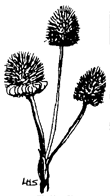Greenacres Links
Landscaping Resources
- Weedlaws
- Toolkit
- Native Vegetation Enhancement
- Wild Ones Handbook
- Homeowners' Resources
- Landscaping Naturally (video)
Remember, we will not post any information intended to directly benefit for-profit enterprises
 Green
Landscaping: Greenacres
Green
Landscaping: Greenacres
Wild Ones Handbook
WHAT EVERY WILD ONE SHOULD KNOW
- How to Naturally Landscape Without Aggravating Neighbors and Village Officials
- Important Causes of Hayfever
- Observational Design
- References
- It Starts With The Soil
- Removing Vegetation
- Handling Wild Seed
- Buying Seed: Pretty Packages No Substitute For Patience and Local Seeds
- Planting A Prairie
- Prairie Maintenance
- Planting A Woodland
- Creating A Water Garden
- Landscaping For Wildlife
- Wood Projects
- Planting Policies
- Aggressive Species
|
"All the flowers of Unknown |
Pretty Packages No Substitute for Patience
And Local Seeds
by Wendy Walcott, Prairie Future Seed Co.
Advertisers know that the greatest temptation is the promise of instant satisfaction. Inexpensive seed packets with colorful photos of western annuals are accompanied by 'easy' directions. Cheap and labeled "Midwestern" or "part-sun" or "damp area mix" -- how much can you lose?
Because of bright annuals, some of these plantings can be attractive, at least at first. They may even produce a second-year carpet of Black-eyed Susans. But the long-term perennials, suited to the environment, are mostly missing. One problem for preservationists is the introduction of non-local genotypes: If our Stiff Coreopsis is already scarce, it may disappear when a more vigorous western strain appears nearby. Native landscapers worry about the berms of Bull Thistle and Curly Dock; the patches of Old World pasture grass sparsely dotted with non-hardy annuals; and three years later, the monocultures of alien Daisies, Yarrow, or Queen Anne's Lace that are left. The promise of maintenance-free and ecologically sound beauty has not become reality, and the disappointed sower may cut it down and go back to grass, this time for good!
The truth is, creating a little piece of self-sustaining ecosystem is not easy. After all, it has taken many years and millions of dollars in mowing machines, earthmovers, herbicides, and public works salaries, to eliminate almost all the native habitat from road and trackside, field and suburb. Why should all that diversity come back overnight, at low cost? Restoration takes time and knowledge. Local native seed is expensive because it's difficult to collect. Diversity is essential to success, but unpredictable. When a planting is done right from the start, however, the payoff comes after three or four years, when enough different flowers and grasses have succeeded to provide interest during all seasons, and no one species has been able to dominate all others.
To successfully change lawn into prairie meadow there are three essential requirements: realistic expectations; good preparation of a truly weed-free planting area; and a seed mix of at least two to three dozen species exactly suited to the area -- balanced between nurse species and pioneer, early succession and climax species.
Coming up with such a mix demands knowledge of the local environment and experience with native plant needs that cannot be had by any "meadow-in-a-can" mix. Of the few perennials in those generic mixes, one species will have become dominant by the fourth year, resulting in a non-native monoculture that blooms only for a few weeks. Shasta Daisy is a commonly used weedy horticultural. Bachelor's Button and Baby's Breath have caused problems in some Wisconsin areas. One of the worst choices is Dame's Rocket, a Eurasian mustard. This plant may not be a problem in California, Oregon, or Vermont, but it is so successful in damper, shadier spots that it entirely dominates and destroys our native forest-edge species. Yet it is a leading filler in so-called Midwestern wild flower mixes, because it is cheap and showy. Chickory, Bouncing Bet, and Eurasian Yarrow are other dominators. Native Canada Goldenrod (but not other goldenrods) and Yarrow can become too aggressive. They are best left out of seed mixes or included very sparingly.
If your original custom mix included the following, you have a planting well on its way to self-sufficiency, stabilized by its diversity.
- Two to three nurse species -- Good cover choices are annual flax, annual rye (be careful not to get perennial), oats and, for fall seeding, winter wheat.
- Two to six pioneers -- that is, speedy colonizers of disturbed spots that help stabilize the soil and are compatible with the future perennials. They also preempt the non-native, super-successful weeds such as Queen Anne's Lace and Canada Thistle. Typical pioneer plants for wet to mesic sites are native Wild Rye, Black-eyed Susan, and Evening Primrose.
- Six to 10 early-succession forbs or grasses -- Yellow Prairie Coneflower, Bee Balm, Stiff Goldenrod, New England Aster, Thimbleweed are among the good competitors that fill your newly rescued space with color and enthusiasm.
- Twenty to 30 site-specific grasses and forbs.
By the third and fourth year, you should be getting bloom from some of the perennial grasses and forbs native to original prairies!
![[logo] US EPA](../gif/logo_epaseal.gif)
